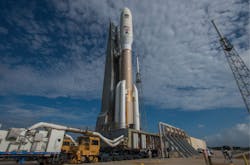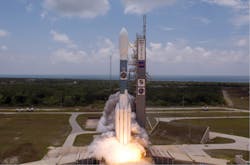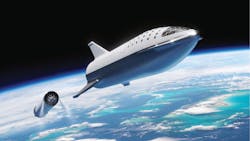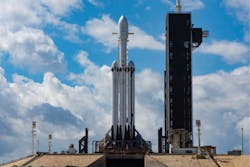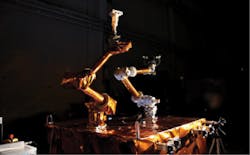By J.R. Wilson
President Donald Trump’s effort to create a Space Force as a new, independent branch of the U.S. military is based largely on concerns about the future of Chinese and Russian efforts in military space, which all three nations recognize as a warfighting domain, alongside air, land, sea, and cyber.
Both potential adversaries have proclaimed their intent to surpass U.S. capabilities in space, with many seeing China’s programs as initiating a new “space race” reminiscent of the U.S. and Soviet competition to put men on the moon in the 1960s.
While the moon once again is a factor, operations in low-Earth orbit (LEO) and geosynchronous orbit (GEO) are foremost in the minds of U.S. military planners and would be the primary domain of the proposed Space Force.
“China has expanded by orders of magnitude. The Russians have newly invested in space and developed some relatively exquisite capabilities,” Kenneth P. Rapuano, assistant secretary of defense for homeland defense and global security, told the Senate Armed Services strategic forces subcommittee in March. “But the scale of the Chinese investment is the lead in terms of everyone else out there, including Russia. They have more rocket launches this year than the United States. They are the lead rocket-launch nation in the world.”Space is pivotal in U.S. military thinking, Rapuano told subcommittee members. “Our targeting, our communications, positioning, timing, location for GPS. All of the ... capabilities in terms of surveillance and reconnaissance that we get from space. Real-time situational awareness of adversaries’ locations and activities. To lose those capabilities would be very significant and that is why we are so focused on defending and protecting them.”
Whether or not the politically charged effort to create a Space Force comes to fruition — and, if so, in what format — the basic technology needs for military space through the 2020s will remain the same: upgrading and replacing legacy systems launched into orbit in the past half century, and defending U.S. space assets from attack, either physical or cyber.
Yet creating a new bureaucracy in the form of a Space Force, in and of itself, is not sufficient to the task, says Fred Kennedy, director of the newly created Space Development Agency (SDA).
“Near-peer and peer competitors have figured out that we gain incredible advantage from our space-based systems and so are investing heavily in ways to directly negate our advantage in space or develop ways to interfere with those capabilities,” Kennedy says.
“The problem is the legacy U.S. organizations have become very good at building out very large, expensive capabilities that take a decade or more to build, which is not within the turning radius of our adversaries,” Kennedy continues. “To move to something that is quick, agile, and responsive is asking a lot of the legacy organizations and culture, so our thesis is to stand up something new, with a new culture dedicated to speed and rapid upgrades, leveraging commercial developments on an 18-to-24-month cycle.”Dramatic change
That is a dramatic change in procurement and deployment times, but Kennedy says SDA also will incorporate what the legacy organizations do best.
“We will pull from the best practices of all organizations, including DARPA’s term-limited appointments for folks who come in and special hiring authorities to get the best and brightest from industry and academia. DARPA has managed to stay fresh for the past six decades by virtue of its quick turnarounds of personnel.”
“SDA is not a technology development activity,” Kennedy says. “It is a production house. I want to keep SDA fairly small, never more than 100 or so military and government employees. I would like to hold to a one-to-one government to contractor ratio, which patterns us after the Air Force Rapid Capabilities Office, using a small number of highly expert personnel.”
Marco Caceres, senior space analyst for The Teal Group Corp. in Fairfax, Va., not only agrees, but says he believes the growing commercial aspect of U.S. military space will keep America ahead of all competitors without the need for a dedicated Space Force.
“There has been a trend for the last 10 or 20 years that commercial launch technologies are outpacing those strictly used by the military. The difference between a commercial imaging satellite and a military satellite is much closer than ever before,” Caceres says. “The military is weighing the options of owning their own satellites versus using commercial. There doesn’t seem to be any willingness on the part of Congress to provide huge amounts more money for military space. Even if there is a separate Space Force, I’m not sure that necessarily means the U.S. military will own and operate its own rockets — or what that rocket would be, at this point.”“I doubt the launch vehicle situation will change, primarily because of cost,” Caceres continues. “As launch prices come down and the you see the development of new vehicles catering to the entire launch market, I think the military will continue to buy launch services from two or three providers. On the satellite side, there will be a move by the military to develop cutting edge technologies in terms of imaging and early warning, etc., but those satellites will be extremely expensive to develop and build. So, unless Congress allocates a lot more money, there will be pressure on the military to look to private industry to host their payloads — or just lease capacity on commercial satellites.”
Caceres and Kennedy agree that this is not a negative but rather a significantly positive approach that will keep the U.S. ahead of its non-capitalist opponents.
“The Chinese and Russians are catching up in terms of their space capabilities,” Caceres says. “We’re still ahead, but there was such a huge gap that we could only continue for a limited amount of time. But they’re still behind and, with our commercial efforts, we’re doing a lot more than either. The Russians are using technologies developed in the 1960s and ‘70s. The Chinese are only doing what we did decades ago. And once you get the ability to reuse your rocket and relaunch in a couple of days, how can the Russians and Chinese compete with that?”Constellations replace big satellites
The U.S. Air Force Space Command (AFSC) today handles the majority of military space efforts on behalf of the other services and joint operations. AFSC Chief Scientist Joel Mozer believes his legacy organization has learned the lessons upon which Kennedy plans to build SDA — especially moving away from big, expensive satellites to a dispersed constellation of small satellites that can be replaced quickly as new technologies evolve.
“The capabilities we have in orbit today were designed, in many cases, for 20-year lifetimes. That isn’t to say we won’t be upgrading some, such as GPS. We have big GEO satellites going up today that will be around for a while,” Mozer acknowledges. “But the trend is to go away from those big, billion-dollar single assets to smaller, distributed capabilities in orbit.”
Air Force Lt. Col. Thomas Niday, AFSC’s chief of advanced concept requirements & transition, adds a critical key to greater reliance on commercial systems is to ensure they have the level of assurance required for military missions that often far exceed commercial needs. Military-level operations also will require a greater implementation of artificial intelligence (AI).
“AI and machine learning will be critical to rapid, effective decision-making,” he tells says. “Without that, the amount of data and the speed required will overwhelm the capacity of unaided operators. So, to quickly assess what is happening will require AI. That is not the same as autonomy, but in support of the operators, assisting them in making rapid decisions.”
“AFSC has a lot of innovative S&T [science and technology] efforts underway, a lot of that with industry and academia and government labs, not just AFRL, but DIU [Defense Innovation Unit] and many more,” Niday says. “We are looking to help AFRL influence what those organizations are doing in space and help foster those technologies to benefit the joint warfighter in the future.”Servicing legacy satellites
DARPA is launching a new research effort called Robotic Servicing of Geosynchronous Satellites (RSGS) to keep the large legacy GEO satellites functioning, updated, refueled, and even moved to new orbits. RSGS Program Manager Joseph Parrish says on-orbit servicing is in a transformational stage, building on two decades of DARPA and commercial technology development to be on the cusp of actual deployment, sometime in the early 2020s.
“Most of our targets will be legacy satellites and we are well aware of the limitations and capabilities that RSGS will have in dealing with them,” Parrish says. “We’re looking at an operational system to service 20 to 30 spacecraft — a combination of government and commercial — in GEO over a multi-year lifetime.”
“Robotic manipulators are at the heart of the system, but we’re also applying machine vision to approach target spacecraft so the robot can identify the object and where to reach out and touch it without having a human directing the operation,” Parrish continues. “We also have technologies associated with self-protection, to keep it from running into the client spacecraft, and to limit the pressure exerted. We have two manipulator arms, one to grasp the client spacecraft while the other does the operations. The target satellite has its own attitude control system that needs to be inhibited so we’re not fighting it. The command to inhibit actually comes from the ground control station in cooperation with the client.”
The tools, fuel, and other components that RSGS will need to repair or upgrade a target spacecraft will be launched into GEO separately in pods, with which the repair satellite will rendezvous before working on a specific satellite.
“That eliminates the need to launch the RSGS with every possible tool or item it might need in the future,” Parrish says.
The RSGS will be designed to handle four types of operations:
- close inspection, or grappling to the client and using cameras on the RSGS to look for micrometeorite damage down to a centimeter in diameter;
- anomaly resolution, or at launch the spacecraft has solar arrays, communications antennas and anything else that on orbit folds out from the spacecraft;
- orbit adjustment, or grappling to the target and moving it around GEO to another location or out of GEO to a “dead” orbit; and
- installation of upgraded capabilities, or attaching boxes or other items to the client spacecraft using the robotic manipulators.
“It doesn’t happen often, but sometimes something will get in the way of that deployment,” Parrish explains of the anomaly resolution segment. “So at the beginning of its life, at its highest value ever, it can’t come out of the starting block if the solar arrays or the communications antennae don’t deploy. Sometimes it only takes a pound or two of applied force to fix that, which most GEO satellites do not have themselves.”
The RSGS also will be designed to upgrade itself, using components launched into orbit in pods.Keeping GEO satellites in orbit
While it will employ special techniques to replace or repair components or perform on-orbit refueling on legacy satellites not designed for those, DARPA will be working with the producers and users of future GEO satellites to make docking and accessing the areas and components being updated or repaired much easier.
A major point of debate for almost any new technology that U.S. Department of Defense leaders plan to put into space will be international agreements against weaponizing space. Teal’s Caceres says even RSGS could be seen as offensive by other nations — or converted to offensive capabilities.
“The Air Force has been wanting to develop laser communications technology for a decade or more,” Caceres continues. “Laser capability in general for space and the ability to refuel and repair satellites in orbit are considered relatively benign technologies, but if you can scoot up to a satellite to repair it, you have the ability to destroy it.”
SDA is focused on deploying new space technologies in capability layers. Key areas include navigation; countering GPS denial with alternate navigation capabilities; and creating disaggregated apertures in radio frequencies that would not rely on large antennas.
“Something else of critical importance is autonomous, perhaps AI-enabled, battle management,” Assistant Defense Secretary Rapuano told lawmakers. “If we have to defend against high-speed weapons, such as hypersonics, we will only have seconds to minutes to respond, which will require a lot of the tactical edge to be on orbit. That is only in development now by DARPA,” Rapuano told Congress, adding that future space technologies must be capable of offensive and defensive operations.“Missile defense technology, for example, and maintaining knowledge of adversary assets; constant custody of time-sensitive targets worldwide, which could include hundreds of targets, 24-7 — we can’t wait for a picture to be taken and examined and then have the information to act an hour later,” Rapuano told Congress. “An advanced navigation network that will allow us to put extremely precise clocks aboard spacecraft will be important and portions of the AI/military element to enable rapid, autonomous battle management will be critical.
“We don’t have to spend a lot of time working on advanced sensors for IR in advanced warning; most of the capability is available to us now, Rapuano continued. “Most of the sensor problems will be building out the quantity we need in a reasonable amount of time instead of only a couple in a number of years. That will be an interesting change to the mindset of the average payload developer.“
New space technologies
A wide range of new and evolving technologies are expected to find a home in military space in the next decade. Satellites will continue to get smaller — micro and nano satellites, even smaller. That has required an ongoing shrinkage in microelectronics.
“With the development of commercial systems such as Starlink [a SpaceX broadband Internet effort], with constellations of thousands of satellites covering the globe, the question is can the military equate or improve on that — or will they just lease capacity on those satellites,” The Teal Group’s Caceres says. “Everything is communications. Speed, capacity, whether it is targeting, navigation, timing, depends on communications sats. Keeping our GPS satellite system in good working order and as modern as possible is key.”
“If we are fighting a war, in space or on Earth, we must be able to communicate,” Caceres continues. “You can have a lot of other fancy stuff, such as lasers, but if you can’t communicate quickly and have everyone on the same page, you won’t have an edge. If you also can have access to space anytime you want by the use of reusable launch vehicles, you’re ahead. Right now, we can’t do more than one or two Delta or Atlas launches a month. If you can launch every few days, you have a huge advantage. And having reusable launch vehicles, such as SpaceX, is cutting edge technology.”
In addition to being fully reusable, SpaceX is working on what will be the largest and most powerful launch vehicle ever built — the recently renamed (from Big Falcon Rocket or BFR) as the Starship Super Heavy. SpaceX CEO Elon Musk says the 387-foot two-stage rocket, set to begin initial testing this year, is designed to carry up to 100 people and 150 tons of food, water, and other supplies to Mars as part of colonization effort, beginning as early as the mid-2020s. In the interim, it will return humans to the moon.
“If Musk makes his BFR rocket real, it will make every rocket in the world obsolete overnight,” Teal’s Caceres says. “The U.S. military can’t possibly match that — nor can NASA. If the new rockets being funded by all these multi-billionaires do what they’re supposed to, there’s no reason for the military or NASA to spend hundreds of millions of dollars to try to match that. The same is true with satellites. Why not just tap into the system and make sure there are safeguards?”
In addition to providing a technology capability no other nation, especially Russia and China, have or can match, relinquishing the future evolution of military space to private industry resolves the inherent problems of government programs that have kept humans from the moon for nearly half a century and forced U.S. astronauts to pay Russia for access to the International Space Station since the Space Shuttle’s last flight in 2011.
“The only thing that has changed with the proposal for a Space Force is the idea of having a more independent body that supposedly can respond more quickly to developing technologies. But until you dramatically reform the procurement process, it doesn’t matter if you have an independent Space Force or one under another service,” Caceres says.
“The problem with procurement is every time you get ready to develop and set your goals and time lines, somewhere along the process somebody comes along and says a new technology has been developed and if it was put on the system we’re close to finishing, it would add capability — but also would add cost and delay development. This keeps happening and is how these programs keep getting stretched out for years until ultimately Congress says we need to cancel them. So, having a new department won’t make any difference by itself.”
